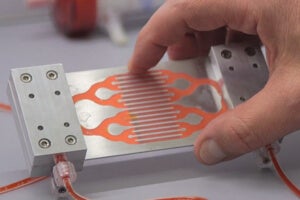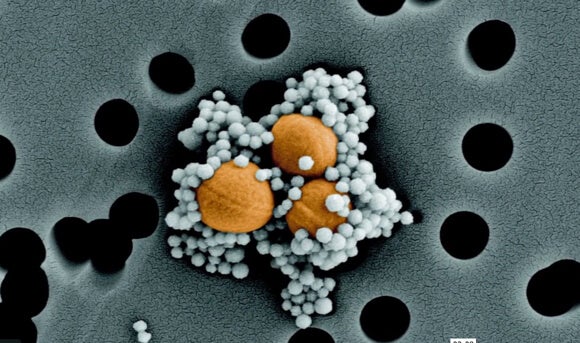In one of the gutsiest performances in sports history, NFL quarterback Chris Simms had to be carted off the field after taking several vicious hits from the defense during a game in 2006. Remarkably, Simms returned to the game shortly thereafter and led his team on a scoring drive before having to leave the game for good.
As it turns out, Simms had ruptured his spleen and lost nearly five pints of blood.
While you can live without your spleen, it serves several important functions in the body including making antibodies and maintaining a reservoir of blood. It also works to keep the blood clean by removing old blood cells and antibody-coated pathogens.
Now, scientists from Harvard’s Wyss Institute for Biologically Inspired Engineering in Boston have developed an artificial spleen that has been shown to rapidly remove bacteria and viruses from blood. The technology could be useful in many scenarios, including protecting people who suffer from immunodeficiencies and those infected with difficult to treat pathogens like Ebola virus. It also has great potential to reduce the incidence of sepsis, a leading cause of death that results from an infection that the immune system tries but fails to control effectively.
In the 2013 sci-fi thriller Elysium, the filmmakers imagined a futuristic body scanner that can quickly identify and treat almost any disease. While we may be far from an all-in-one machine that can handle any ailment, the artificial spleen developed by a Harvard team led by Dr. Donald Ingber could play a part in such a machine.
Their work, published last month in the journal Nature Medicine, was demonstrated to be effective in removing more than 90% of bacteria from blood.
While this device has potential to be a major advance in treating infections, the way it works is relatively straightforward. In most animals, a protein called mannose-binding lectin (MBL) binds to mannose, a type of sugar. Mannose is found on the outer surface of many pathogens, including bacteria, fungi and viruses. It is even found on some toxins that are produced by bacteria and contribute to illness.

Dr. Ingber’s team took a modified version of MBL and coated magnetic nanobeads with it. As the infected blood filters through the device, the MBL from the nanobeads binds to most pathogens or toxins that are around. As the blood then moves out of the device, a magnet grabs the magnetic nanobeads that have attached to the pathogens and removes them from the blood.
The blood can then be put right back into the patient, much cleaner than before.
In their initial experiments, the researchers used rats that had been infected with two common bacteria, Escherichia coli and Staphylococcus aureus. One group of rats was left untreated and the other group had their blood filtered using the new device. After five hours, 89% of the treated rats had survived while only 14% of the untreated rats were still alive.
The researchers also tested if the device could be effective for humans, which have about five liters of blood in an average adult. In five hours of testing, moving one liter of blood infected with bacteria and fungi through per hour, the device worked to remove the vast majority of the infectious bugs.
While five hours is a not a long time for patients who are hospitalized, it’s a bit long for patients who might be receiving outpatient treatment for an infection.
It is possible that as the design and function of the device is improved, it could work even faster than one liter per hour. The speed at which the artificial spleen is effective likely depends on several factors, including the pathogen load, the size of the patient (and thus their actual volume of blood) and the number of magnetic nanobeads in the device working to bind the pathogens.
Currently, the researchers are extending their experiments by testing the artificial spleen on a larger model animal, the pig.
If the device eventually makes it to market, it might provide a big boost to our arsenal against infectious microorganisms. It can bring the numbers of rapidly dividing bugs down to a level that can then make it easy for drugs or even just the immune system to finish them off, an important advancement for people who suffer from an immunodeficiency for any number of reasons. This device could also help reduce our overuse of antibiotics and give us a strong weapon against antibiotic-resistant bugs.
It might even find use in developing countries like those in Western Africa, where we are currently witnessing the devastation of the Ebola virus outbreak.
However, while many infectious bugs have mannose on their surface, not all of them do. Perhaps the 2.0 version of the artificial spleen will include proteins that can bind to other molecules on the surface of problematic microorganisms, leading us closer to the all-in-one healing machine imagined in the futuristic world of Elysium.
Image Credit: Wyss Institute/Vimeo




